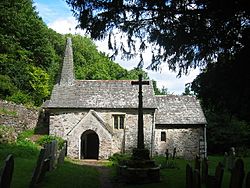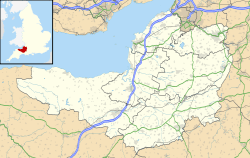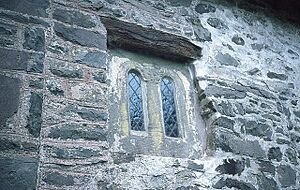Culbone Church facts for kids
Quick facts for kids St Beuno's Church, Culbone |
|
|---|---|
 |
|
| 51°13′17″N 3°39′32″W / 51.2213°N 3.6590°W | |
| OS grid reference | SS842482 |
| Country | England |
| Denomination | Church of England |
| History | |
| Status | Parish church |
| Dedication | St Beuno |
| Architecture | |
| Functional status | Active |
| Specifications | |
| Length | 35 feet (11 m) |
| Administration | |
| Parish | Porlock |
| Diocese | Bath & Wells |
Culbone Church is a very special place located in the small village of Culbone in Somerset, England. People say it's the smallest parish church in all of England! A parish church is a church that serves a local community.
This church is dedicated to a Welsh saint named Beuno. It's so old and important that English Heritage has given it a special status as a Grade I listed building. This means it's considered a building of exceptional historical interest. Even the cross in its churchyard is listed as Grade II*, which means it's also very important.
Contents
History of Culbone Church
How Old Is It?
Culbone Church is incredibly old! It was even mentioned in the Domesday Book, which was a huge survey of England ordered by William the Conqueror way back in 1085. This means the church was already there almost 1,000 years ago!
The church probably existed even before the Normans came to England in 1066. Parts of it, like the entrance area (called a porch), were added in the 1200s. The main part of the church (called the nave) was built later, in the late 1400s.
Changes Over Time
Over the years, the church has had some updates. Around 1810, new windows were put in, and the roof was replaced. In 1888, a small spire (a pointy tower) was added to the roof. The church also had more repairs and improvements in 1928 to keep it in good condition.
Famous People Connected to the Church
Some interesting people are connected to Culbone Church:
- Joan D'Arcy Cooper was a psychologist and a Yoga teacher. She wrote a book called Guided Meditation and the Teaching of Jesus. She used to play the organ at the church and is buried in its graveyard.
- A soldier from the Welsh Guards who fought in World War II is also buried in the churchyard. This is a special grave looked after by the Commonwealth War Graves Commission.
- Sir David Calcutt, a famous lawyer and public servant, is also buried here.
Even though it's hard to get to, church services are still held regularly at Culbone Church.
Inside Culbone Church
Ancient Design and Features
When you step inside Culbone Church, its small size and decorations make you think it might have been built by the Anglo-Saxons, who lived in England before the Normans. The front part of the church (the east end) has been repaired and looks good.
There's a tiny window on the outside of the north wall of the chancel (the area around the altar). It's carved from a single block of stone and has a face on top of the pillar that divides the window. This window is probably from the Saxon period too!
Seating and Size
The main part of the church, the nave, has old-fashioned wooden seats called box pews. One of these is a special "squire's pew" from the Jacobean era (the early 1600s). This pew was for the owner of a nearby large house called Ashley Combe House.
The church is quite small and can only seat about 30 people.
- The chancel is about 13.5 feet (4.1 meters) long and 10 feet (3 meters) wide.
- The nave is about 21.5 feet (6.6 meters) long and 12.3 feet (3.7 meters) wide.
- The entire building is about 35 feet (10.7 meters) long.
The font, which is a basin used for baptisms, sits on a Victorian-era stand. However, the bowl of the font itself is much older, possibly even from the Saxon period.
Church Bells
Culbone Church has two bells. The older bell was made in the 1300s, and the newer one dates back to the 1600s.
How to Visit Culbone Church
Getting to Culbone Church is an adventure because you can't drive right up to it!
- The church is located along the South West Coast Path, which is a long walking trail.
- If you're driving, you need to turn off the A39 road across from the village pub.
- You can park your car on a narrow track as best you can.
- From there, it's about a 1.5-mile (2.4-kilometer) walk through the woods.
The writer Simon Jenkins described this walk as "through steep woods of walnut and oak, glorious on a summer's day with the sea glinting through the trees, darkly mysterious and dripping with water in winter." It sounds like a beautiful but challenging journey!
See also
- Grade I listed buildings in West Somerset
- List of ecclesiastical parishes in the Diocese of Bath and Wells



